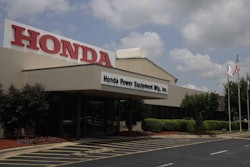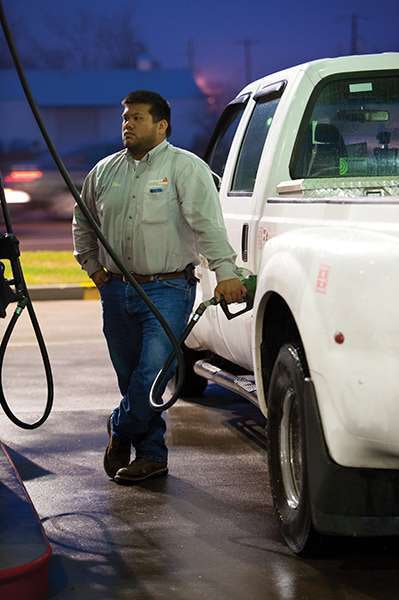
There’s no single topic in the automotive world that gets talked about more often, costs vehicle manufacturers untold millions in research and spawns more aftermarket products touting improvements than fuel economy.
When we start shopping for a new vehicle, we immediately think about fuel economy; when we talk to our friends and co-workers about what we drive, undoubtedly somewhere in the conversation fuel economy pops up; when vehicle manufacturers hype their new vehicles, its fuel economy is a key talking point.
Then there are those in the business world who, like owners of landscaping companies, want to reduce operating budgets by cutting vehicle fuel costs. Maximizing fuel economy means money in the bank to them.
The unfortunate truth is a vehicle’s fuel economy is affected by so many variables that achieving the mpg numbers shown on the vehicle’s sheet is like chasing the rainbow for that pot of gold. It’ll never happen.
What you have to be content with and focus on improving is the mpg your vehicles are getting right now, day in, day out, however they are being used.
What’s behind EPA’s MPG numbers?
That’s because mpg numbers on a vehicle’s window sticker and listed on the U.S. Environmental Protection Agency (EPA) website are the result of six driving cycles run in a lab where every variable that affects fuel economy is tightly controlled.
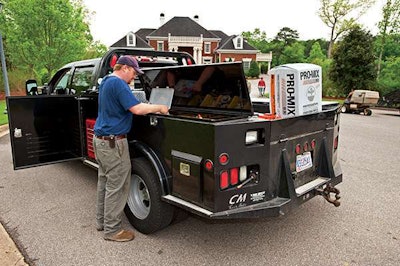 Keeping the contents of your work trucks lean and light will improve fuel economy.
Keeping the contents of your work trucks lean and light will improve fuel economy.The vehicle tested is “representative” of what the manufacturer has for sale related to transmission and engine, and the dyno tests are done by a technician following strict computer protocols.
The tests are short, too. The “city loop” lasts a little more than 31 minutes in total with the equivalent of driving 11.04 miles at an average speed of 21.2 mph. The “highway” test cycle runs a little less than 13 minutes, covering 10.26 miles at an average speed of 48.3 mph. (Details of these tests are on the EPA website.)
Before 2008, those mpg numbers were pretty bogus when compared to real-world driving. That’s when the EPA added “High Speed,” “AC” and “Cold Temp” driving cycle results to factor in more realistic fuel numbers than those in past decades. The added test cycles helped.
Today’s numbers are close to what you and I would see if we drove conservatively. That’s because the new high-speed driving cycle only averages 48.4 mph, and the top speed in that test is 80 mph for about 30 seconds. The entire high-speed test is just 10 minutes with four stops.
So for average Joe landscaper to achieve the window sticker mileage, he’d have to mimic those types of speeds and be rather light-of-foot – and be driving with an empty vehicle.
How to maximize MPG
There are still ways to improve whatever annual fuel mileage numbers the work trucks in your landscaping fleet are presently achieving if the driver has the incentive to do so.
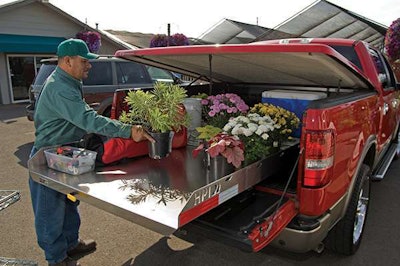 One accessory to help improve mpg is the addition of a tonneau cover if you do a lot of highway driving. (Photo by Larry Walton)
One accessory to help improve mpg is the addition of a tonneau cover if you do a lot of highway driving. (Photo by Larry Walton)(Aftermarket products touting improvements in fuel economy usually don’t pan out on the open road. If they did, the vehicle manufacturers would probably already have the technology and programming incorporated into the new vehicles because they are striving to maximize fuel economy, as well.)
Instead of spending money on chasing that mpg rainbow, focus on the freebies that actually produce results. The two biggest ways to save on fuel without spending money is to be light on the throttle and drive at slower speeds.
A lot of fuel is wasted on jackrabbit starts and hard acceleration. Easing into the throttle and easing out of it so hard braking isn’t needed during turns and stops improve fuel economy.
An even bigger mpg booster is slowing down when towing or driving on the highway or interstates/freeways where speed limits are in excess of 65 mph.
The “maximum” speed limits don’t mean you have to drive at those posted speeds. A pickup’s best fuel economy is achieved between 55 to 60 mph. Driving at 70 mph instead of 60 mph can drop mpg by 2 to 3 mpg on a pickup towing a trailer.
It’s purely a function of aerodynamics and engine rpm: The faster a vehicle goes, an exponential increase in wind drag results, and the higher the engine rpm, the more fuel the engine needs to maintain that rpm.
The difference in fuel economy between cruising at 1,600 rpm and 2,000 rpm on a typical pickup V8, gas or diesel can be clearly seen watching the odometer’s average mileage readout.
More fuel savers
Minimizing weight is also a big factor in improving fuel economy. Keep unnecessary tools and equipment out of the truck and off the trailer. It also pays to run lighter trailers instead of heavy versions, whether open- or box-type. Shaving weight saves money.
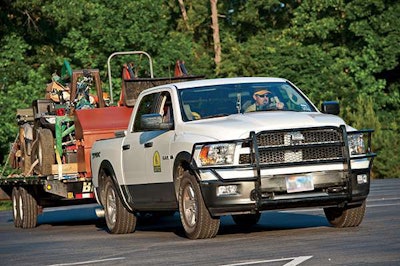 Properly inflated truck and trailer tires help maximize towing fuel economy, as does using aluminum trailers instead of steel trailers where practical.
Properly inflated truck and trailer tires help maximize towing fuel economy, as does using aluminum trailers instead of steel trailers where practical.Here are a few other items that cut into vehicle fuel economy:
- Taller, heavier tires change the truck’s gearing and create more drag and rolling resistance.
- Suspension lifts, winch and racks all increase aerodynamic drag at highway speeds – and add more weight to the truck.
- Under-inflated truck/trailer tires increase rolling resistance and reduce fuel mileage.
- Engine programmers for gas engines that give more power do so at the expense of fuel economy.
- Programming the engine to bypass cylinder-deactivation (V8/V4) mode will also cut mpg.
- Letting the truck sit idling more than a minute wastes fuel.
Getting the best fuel mileage from your fleet of trucks requires paying attention to the little details that play a big role in maximizing fuel economy. There is a pot of gold at the end of the mpg rainbow – it just takes a little work to get there.
Editor’s Note: Bruce Smith is a Senior Editor at Randall-Reilly



